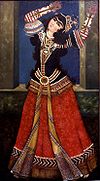
Back المرأة في إيران Arabic ইরানে নারী Bengali/Bangla Mujeres en Irán Spanish زنان در ایران Persian Histoire des femmes en Iran French Condizione della donna in Iran Italian ഇറാനിലെ സ്ത്രീകൾ Malayalam Женщины в Иране Russian ایران وِچ تِرِیمتاں SKR ஈரானில் பெண்கள் Tamil
This article has multiple issues. Please help improve it or discuss these issues on the talk page. (Learn how and when to remove these messages)
|
| General Statistics | |
|---|---|
| Maternal mortality (per 100,000) | 21 (2010) |
| Women in parliament | 6% (2016) |
| Women over 25 with secondary education | 62.1% (2010) |
| Women in labour force | 49% (2011) |
| Gender Inequality Index[1] | |
| Value | 0.459 (2021) |
| Rank | 115th out of 191 |
| Global Gender Gap Index[2] | |
| Value | 0.576 (2022) |
| Rank | 143rd out of 146 |
| Part of a series on |
| Women in society |
|---|
 |
| Part of a series on the |
| Culture of Iran |
|---|
 |
|
|
Throughout history, women in Iran have played numerous roles, and contributed in many ways, to Iranian society. Historically, tradition maintained that women be confined to their homes to manage the household and raise children. During the Pahlavi era, there was a drastic social change towards women's desegregation such as ban of the veil, right to vote, right to education, equal salaries for men and women, and the right to hold public office. Women were active participants in the Islamic Revolution. Iran's constitution, adopted after the Islamic Revolution in 1979, proclaims equality for men and women under Article 20,[3] while mandating legal code adhering to Sharia law. Article 21 of the constitution as well as a few parliament-passed laws give women rights such as being allowed to drive, hold public office, and attend university but not wearing a veil in public can be punished by law;[4] and when in public, all hair and skin except the face and hands must be covered.[5] However, this is often not enforced; notably in recent years, Iranian women have started a number of groups to rebel against the government's oppressive policies and reclaim their independence and rights.[6]
- ^ "Human Development Report 2021/2022" (PDF). HUMAN DEVELOPMENT REPORTS. Retrieved November 28, 2022.
- ^ "Global Gender Gap Report 2022" (PDF). World Economic Forum. Retrieved March 7, 2023.
- ^ "Iran's Constitution" (PDF). Archived from the original (PDF) on February 2, 2022. Retrieved February 16, 2021.
- ^ "Iran: Dozens of women ill-treated and at risk of long jail terms for peacefully protesting compulsory veiling". February 26, 2018.
- ^ "Iran jails woman for removing headscarf in public". BBC News. March 8, 2018. Retrieved February 16, 2021.
- ^ "Women in Iran". WomenInIran. Retrieved September 29, 2022.